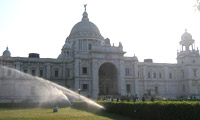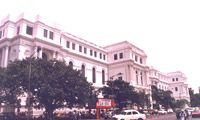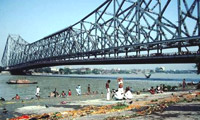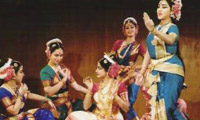History
When the British grew tired of the charms of the trading
town of Hooghly in 1686, they moved downstream to three
villages - Kolikata, Sutanuti and Gobindapur. Led by Job
Charnock, an English merchant, the established a factory
at Sutanuti on August 24, 1690, the date accepted as the
foundation day of modern Calcutta. The British then went
on to build a single post out of the three villages. Ten
years later, a fort was built near what is today known as
BBD Bag and the consolidated city of Calcutta was set up.
In 1707, Calcutta became a separate presidency under the
control of the directors of The East India Company. In 1717,
Mughal emperor Aurangazeb's grandson Farrukh Siyar gave
the Company duty-free trading rights in Bengal for a yearly
payment of Rs 3,000. Calcutta became an important port and
trading centre.
The rapid growth of Kolkata attracted the attention of the
nawab of Murshidabad, Siraj-ufd-Daulah, who attacked it
in 1756 and won the city from the British. Most of the British
inhabitants escaped, but nearly 146 of them were captured
and imprisoned in a narrow cell. Only 26 survived the incident
which went down in history as the Black Hole tragedy. A
year later, in 1757, Calcutta was recaptured by Robert Clive,
who also captured the French settlement of Chandernagore.
He tempted Siraj's uncle Mir Jafar to ally with him. Betrayed
by his own men in the Battle of Plassey, Siraj-ud-Daulah
was assassinated in Murshidabad.
In the late 18th century, Calcutta turned into a prime trading
centre and opened up to better infrastructure and advanced
education. Calcutta became the centre of what would develop
into the Bengal Renaissance, spawning many of India's reform
movements. With resentment towards the East India Company
growing, it was only a matter of time before the first strains
of rebellion broke out. In 1857, Mangal Pandey, a sepoy
with the Indian troops, shot his senior officer at Barrackpore
near Calcutta, in an event that was to soon develop into
the Sepoy Mutiny. The revolt spread through the country,
but was quelled by the British who then assumed complete
control of India and declared Calcutta the Imperial Capital.

A strong national awakening now took shape in Calcutta.
On October 16, 1905, Lord Curzon, the then Governor General
of Bengal, partitioned Bengal. This move was intended to
stamp out growing nationalist sentiment, but it had the
opposite effect. Calcutta became the hub of the Indian independence
movement. The Partition was revoked in 1911, and the capital
of India shifted to New Delhi.
However, with the Partition of the country in 1947, Calcutta
became home to thousands of refugees fleeing their former
homes in East Pakistan. More refugees poured into the city
with the Bangladesh independence movement in 1971. Kolkata
was now a city almost bursting at its seams.
In 2001, Calcutta was officially renamed Kolkata.
Culture
It's the most laid-back city in the world. Yet, if you start
your trip to Calcutta with a walk down the "lungs of
the city" - the sprawling Maidan - as early as 5 in
the morning, you'll find people walking, jogging, stretching,
and catching up with one another.
It's the home of a mind-boggling array of sweets and dishes.
Yet, it isn't out of place to find a Bengali enjoying his
morning cuppa with a handful of humble puffed rice.
It's difficult to define the culturescape of Calcutta to
a tourist, because it begins with the first sip of early-morning
tea, poured out into a saucer and sipped noisily, with raucous
exclamations of delight. Kolkata is a wonderful mirror of
the Bengalis who call it home - volatile poets, sensitive
artists and romantic men and women. It's the city of the
artsy, the quaint, the intellectual - indeed, of anyone
with an enormous zest for life. 
For the traveler in Calcutta, the best way to enjoy the
culture of the city is to find a friend there and sit down
for an adda - local parlance for a chat session. This chat
is conducted, not on dinky online messengers, but in the
comfort of someone's living room, in the smoky confines
of a coffee house, on the steps of a college, at the bus
stop, at the corner of the daily market… just about
anywhere two or more people can get together. And what do
they talk about? Politics, sports, religion, books, art,
films, music, the news, food… just about everything
under the sun is worth talking about for the Calcuttan.
Don't be stunned by arguments - though Calcuttans are passionate
about most things, addas never end on an ugly note.
If you're traveling to Calcutta for the first time and want
to experience the music here, you might find an aspiring
singer in every home. A good evening of culture should see
you soak in the spirit of Rabindranath Tagore, Uday Shankar,
Jamini Roy and Satyajit Ray.
Food is Calcutta's greatest indulgence. Bengalis love to
eat, and their great hosts. Every meal ends with the choicest
of dessert, and Calcutta's range of sweets can leave you
quite winded! Every district in the state has a sweet that
is unique to it! Calcutta is also great for junk-food lovers,
though a tourist in Calcutta would do well to avoid these.

Festivals are an intrinsic part of the city - more a socio-cultural
phenomenon than a religious one. Besides these, Calcutta
is also home to a variety of fairs, film fests, music conferences
and folk fairs. It's also home to a cosmopolitan crowd -
Marwaris, Parsis, Anglo Indians, Jews, a smattering of Armenians
and the merry people of China Town all call Kolkata their
city of joy.
For the tourist, Kolkata holds a plethora of places to see.
Museums, galleries, heritage buildings, amusement parks,
temples, churches, synagogues - there's something for every
kind of tourist in Calcutta.


| Properties | TAC | Visas | Ecotel |
| Online Reservation | Contact Us | Home |
